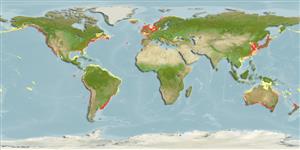Ascidiacea |
Stolidobranchia |
Molgulidae
Environment: milieu / climate zone / depth range / distribution range
Ecology
Sessile; brackish; depth range 0 - 90 m (Ref. 1603). Temperate; 90°N - 41°S, 180°W - 180°E
Indo-Pacific, Atlantic Ocean, Mediterranean, and the Arctic: Europe. tropical to temperate.
Length at first maturity / Size / Weight / Age
Maturity: Lm ? range ? - ? cm Max length : 4.0 cm WD male/unsexed; (Ref. 1749)
Attached to hard substrata or loosely attached on sandy bottoms; from lower shore to depths of about 90 (Ref. 1603). Wharf piles, ships, etc. sea grass, sand or muddy substrates in large aggregates, to 30 m, in salinity 11 to over 20 parts/thousand (Ref. 1134).
Life cycle and mating behavior
Maturity | Reproduction | Spawning | Eggs | Fecundity | Larvae
Members of the class Ascidiacea are hermaphroditic; both cross- and self-fertilization is typical. Life cycle: Eggs develop into lecithotrophic larva before metamorphosing into benthic adults.
de Kluijver, M.J. and S.S. Ingalsuo 2006 Tunicata: Macrobenthos of the North Sea. Zoological Museum, University of Amsterdam. http://ip30.eti.uva.nl/bis/tunicata.php (Ref. 1603)
IUCN Red List Status
(Ref. 130435: Version 2025-1)
CITES status (Ref. 108899)
Not Evaluated
Not Evaluated
Threat to humans
Human uses
| FishSource |
Tools
More information
Trophic EcologyFood items (preys)
Diet composition
Food consumption
Predators
Life cycleReproductionMaturityFecunditySpawningEggsEgg developmentLarvae PhysiologyOxygen consumption
Human RelatedStamps, coins, misc.
Internet sources
Estimates based on models
Preferred temperature
(Ref.
115969): 8.4 - 24.3, mean 13.5 (based on 1814 cells).
Fishing Vulnerability
Low vulnerability (10 of 100).
Price category
Unknown.
